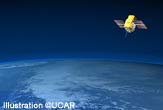Global Warming Affects Space Station Orbit

As the climate warms near Earth's surface, the upper atmosphere is getting less dense, a change that will mean less drag on satellites, scientists announced today.
Carbon dioxide emissions from the burning of fossil fuels will cause a 3 percent reduction in air density in the outermost layer of the atmosphere by 2017, the researchers predict.
Among the affected satellites: The International Space Station and the Hubble Space Telescope.
"We're seeing climate change manifest itself in the upper as well as lower atmosphere," said Stan Solomon of the National Center for Atmospheric Research (NCAR). "This shows the far-ranging impacts of greenhouse gas emissions."
- Video: How it Works
The finding was presented today at a meeting of the American Geophysical Union in San Francisco.
The thermosphere extends from about 60 miles above Earth to 400 miles. The air is incredibly thin, but still causes drag on satellites in low Earth orbit. NASA routinely boosts the orbit of the space station as it is constantly degrading. Other satellites have limited life spans in part because the thin air up there eventually drags them down.
A thinning thermosphere means satellites can stay aloft longer.
Sign up for the Live Science daily newsletter now
Get the world’s most fascinating discoveries delivered straight to your inbox.
Carbon dioxide molecules absorb radiation. Near Earth's surface, the molecules collide frequently with other molecules and the energy is released as heat, warming the air, the scientists explained. In the much thinner thermosphere, a carbon dioxide molecule has ample time to radiate energy to space because collisions are infrequent. The result is a cooling effect. And as it cools, the thermosphere settles, so that the density at a given height is reduced.
- Video: The Greenhouse Effect
The effect varies with changes in the 11-year cycle of the Sun's activity, too. Being able to now predict the changes will help satellite operators plan better, the researchers said.
"Satellite operators noticed the solar cycle changes in density at the very beginning of the Space Age," Solomon said. "We are now able to reproduce the changes using the NCAR models and extend them into the next solar cycle."
The findings are also detailed in the journal Geophysical Research Letters and explained in a video presentation.
Hot Topic

Other Effects
- Seas Rise
- More Wildfires
- Deserts to Grow
- Mountains Grow
- Ground Collapses
- Glaciers Disappear
- Allergies Get Worse
- Summer Gets Longer
- Animal DNA Changing
- Animals Change Behavior
- Rivers Melt Sooner in Spring
- Increased Plant Production
- Hurricanes Get Stronger
- Some Trees Benefit
- Lakes Disappear
Earth's Atmosphere
Gravity holds gases near to the Earth to create the atmosphere, its volume composed 78 percent of nitrogen, 21 percent of oxygen, and 1 percent of argon, plus an abundance of other gases in smaller amounts.
The exosphere extends up about 1,500 miles (more than three times the height of this chart). It has minimal air and constantly loses molecules to outer space.
It's hottest in the thermosphere, exceeding 3,600 degrees. In the mesosphere, temperatures plummet to more than 100 degrees below zero [learn more about temperatures in space].
The stratosphere is warmer but still below freezing. The thinnest layer, the troposphere, holds about 90 percent of all the gases, sustaining life and producing weather.
Water vapor in the atmosphere ranges from zero to about 4 percent.
Robert is an independent health and science journalist and writer based in Phoenix, Arizona. He is a former editor-in-chief of Live Science with over 20 years of experience as a reporter and editor. He has worked on websites such as Space.com and Tom's Guide, and is a contributor on Medium, covering how we age and how to optimize the mind and body through time. He has a journalism degree from Humboldt State University in California.










